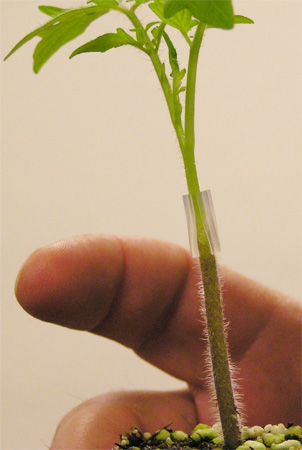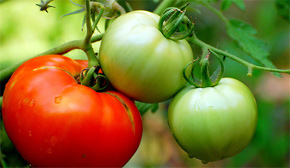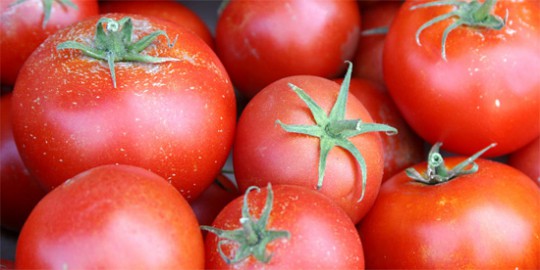Weekend Gardening: Choosing Heirloom Or Hybrid Tomatoes
March 16, 2013
 Tomatoes are a favorite of backyard gardeners. Fresh-grown tomatoes are packed with flavor and nutrition. Due to their popularity, many different types of tomatoes have been developed and selected over time. Choosing the best type for your individual growing situation will increase your chance of enjoying a mouth-watering tomato sandwich on a hot summer day.
Tomatoes are a favorite of backyard gardeners. Fresh-grown tomatoes are packed with flavor and nutrition. Due to their popularity, many different types of tomatoes have been developed and selected over time. Choosing the best type for your individual growing situation will increase your chance of enjoying a mouth-watering tomato sandwich on a hot summer day.
Heirloom vegetables are back in vogue. A tomato must meet three criteria to be considered an heirloom variety. The variety must grow “true to type” from seed saved from each fruit, the seed must have been available for more than 50 years and the variety must have a history or folklore of its own. Heirloom vegetables are also called open-pollinated or non-hybrid.
Heirloom tomatoes are known for their full flavor and excellent taste. Gardeners who start their plants from seeds have always had many choices available to them. This year, I was surprised to see some heirloom seedlings in stores including ‘Cherokee Purple.’ This is an heirloom from Tennessee rumored to have come from Cherokee gardeners. Its rich flavor is said to be similar to the much-celebrated Brandywine.
While heirlooms offer better flavor, they do have a downside. Their biggest weakness is that they are not generally disease resistant and therefore more susceptible to devastating and sometimes fatal diseases. Heirloom varieties also experience more fruit defects such as cracking and catfacing.
 To overcome the potential disease pitfall of heirloom varieties, many gardeners are now grafting their tomato seedlings. In the case of heirloom tomatoes, grafting involves connecting the shoot of the heirloom variety to the roots of a disease-resistant rootstock. The cut pieces are held together by a grafting clip until the tissues grow together (pictured left).
To overcome the potential disease pitfall of heirloom varieties, many gardeners are now grafting their tomato seedlings. In the case of heirloom tomatoes, grafting involves connecting the shoot of the heirloom variety to the roots of a disease-resistant rootstock. The cut pieces are held together by a grafting clip until the tissues grow together (pictured left).
To learn more about heirloom tomatoes and grafting, read the UF/IFAS publication entitled, “Growing Heirloom Tomato Varieties in Southwest Florida.” It’s available online at http://edis.ifas.ufl.edu/hs174 or by calling your local Extension Office.
Hybrid tomatoes are those that have been breed and selected for their disease resistance and productivity. They are the first-generation cross between two “pure” parental lines.
The simplest way to define an F-1 hybrid is to take an example. Let’s say a plant breeder observes a particularly good growth-habit in a plant, but with poor flower color, and in another plant of the same type they see good color but poor habit. The best plant of each type is taken and self-pollinated (in isolation) each year and, each year, the seed is re-sown. Eventually, every time the seed is sown the same identical plants will appear. This is known as a ‘pure line.’
If the breeder then takes the pure line of each of the two plants they originally selected and cross pollinates the two by hand the result is known as an F-1 hybrid. Plants are grown from seed produced and the result of this cross pollination should have a good habit and good color.
 The vigor of hybridization can increase yields, improve pest resistance and impart other desirable characteristics. Some have credited crop hybridization as a prime reason for our country’s ability to feed larger populations with fewer farmers.
The vigor of hybridization can increase yields, improve pest resistance and impart other desirable characteristics. Some have credited crop hybridization as a prime reason for our country’s ability to feed larger populations with fewer farmers.
A down side of hybridization is that if you collect and save the seed from a hybrid variety, its offspring will show a loss of that hybrid vigor – it will start to revert back to its inbred parents. If you want the vigorous capacity that comes with hybrid varieties; don’t save the seed for replanting. You will have to buy new seed each year.
To learn about tomato varieties recommended for Florida gardens, read the UF/IFAS publication entitled “Tomatoes in the Florida Garden.” It’s available online at http://edis.ifas.ufl.edu/vh028 or by calling your local Extension Office.
Theresa Friday is the Residential Horticulture Extension Agent for Santa Rosa County.
Comments
One Response to “Weekend Gardening: Choosing Heirloom Or Hybrid Tomatoes”




Excellent article, really enjoyed the reading, interesting.